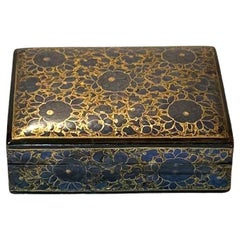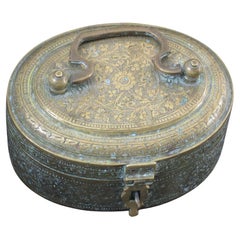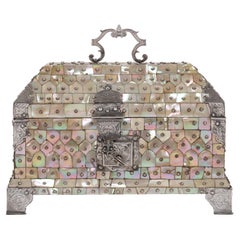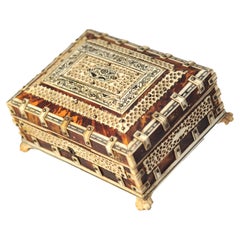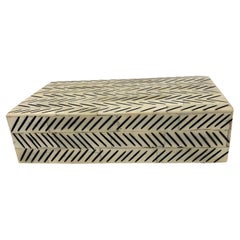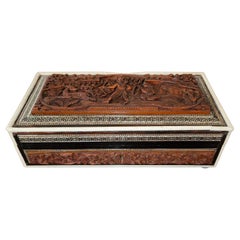South Asian Boxes
to
21
265
33
2
18
97
150
35
53
56
16
7
1
5
3
8
3
4
1
12
8
3
3
3
2
1
1
165
117
71
57
54
222
58
69,868
6,841
1,722
1,706
1,696
Height
to
Width
to
300
289
297
16
4
2
2
2
Place of Origin: South Asian
Kashmir Papier-Mâché Box
Located in Tampa, FL
A wonderful hand-painted papier-mâché box beautifully decorated in a blue and gold. Kashmir, India, circa turn of the century.
Category
Early 1900s Antique South Asian Boxes
Materials
Wood
A Brass Mughal Indian Oval Betel Pandan Box
Located in Ottawa, Ontario
A BRASS MUGHAL INDIAN OVAL BETEL PANDAN BOX
Northern India, early 19th century.
Length: 5 1/4" in. (13.3 cm.) height: 3 1/4" in. (8.3 cm.) width: 4" in. (1...
Category
Early 19th Century Other Antique South Asian Boxes
Materials
Brass
16th-Century Indo-Portuguese Colonial Mother-of-pearl Gujarat Casket
Located in Amsterdam, NL
An exceptional Indo-Portuguese colonial mother-of-pearl veneered casket with silver mounts
India, Gujarat, 2nd half of the 16th century, the silver mounts Goa or probably Lisbon
Measures: H. 16 x W. 24.6 x D. 16.1 cm
An exceptional Gujarati casket with a rectangular box and truncated pyramidal lid (with slopes on each side and a flat top) made from exotic wood, probably teak (Tectona grandis), covered with a mother-of-pearl mosaic. The tesserae, cut from the shell of the green turban sea snail (Turbo marmoratus, a marine gastropod) in the shape of fish scales, are pinned to the wooden structure with silver ball-headed nails. The casket is set on bracket feet on the corners. The masterfully engraved decoration of the silver mounts follows the most refined and erudite Mannerist repertoire of rinceaux and ferroneries dating from the mid-16th century. The high quality and refinement of the silver mounts and, likewise, the silver nails that replaced the original brass pins used to hold the mother-of-pearl tesserae in place indicate the work of a silversmith probably working in Lisbon in the second half of the 16th century.
The Indian origin of this production, namely from Cambay (Khambhat) and Surat in the present state of Gujarat in north India, is, as for the last three decades, consensual and fully demonstrated, not only by documentary and literary evidence - such as descriptions, travelogues and contemporary archival documentation - but also by the survival in situ of 16th-century wooden structures covered in mother-of-pearl tesserae. A fine example is a canopy decorating the tomb (dargah) of the Sufi saint, Sheik Salim Chisti (1478-1572) in Fatehpur Sikri in Agra district in the state of Uttar Pradesh, north India. This is an artistic production, geometric in character and Islamic in nature, where usually the mother-of-pearl tesserae form complex designs of fish scales or, similar to the dishes also made using the same technique, with the thin brass sheets and pins, stylized lotus flowers. The truncated pyramidal shape corresponds, like their contemporary tortoiseshell counterparts also made in Gujarat, to a piece of furniture used in the Indian subcontinent within the Islamic world prior to the arrival of the first Portuguese. This shape, in fact, is very old and peculiar to East-Asian caskets, chests or boxes used to contain and protect Buddhist texts, the sutras.
A similar chest is the famous and large reliquary chest from Lisbon cathedral that once contained the relics of the city's patron saint, Saint Vincent. Both match in shape, having the same kind of socle or pedestal and bracket feet, and in their engraved silver mountings, featuring the same type of refined, erudite decoration. Their differences lie in the silver borders that frame the entire length of the edges of the chest (both the box and the lid), pinned with silver nails, and on the lock plate, shaped like a coat of arms in the Lisbon example. Given the exceptional dimensions of the reliquary casket...
Category
16th Century Antique South Asian Boxes
Materials
Silver
19th Century Eastern Tortoiseshell and Bone Blue Velvet Lined Trinket Box
Located in Reading, Berkshire
Beautiful 19th Century Eastern Tortoiseshell and Bone Trinket Box, Lined with Blue Velvet on Paw Feet.
Ideal for jewellery or keepsakes or just as a ...
Category
Mid-19th Century Moorish Antique South Asian Boxes
Materials
Bone, Tortoise Shell
Black Etched Chevron Pattern Bone Lidded Box, India, Contemporary
Located in New York, NY
Contemporary Indian lidded bone box with etched chevron pattern design.
Part of a large collection of bone boxes
Category
21st Century and Contemporary South Asian Boxes
Materials
Bone
19C Anglo Indian Carved Teak Wood and Sadeli Mosaic Box
Located in Dallas, TX
PRESENTING A LOVELY 19th century Anglo-Indian Carved Teak Wood and Sadeli Mosaic Box, featuring a carving of a Hunt Scene.
Made circa 1870 in Bombay, India during the Rule of the Br...
Category
Late 19th Century Anglo-Indian Antique South Asian Boxes
Materials
Silver, Pewter
Dutch Colonial Miniature Cupboard in Coromandel Wood, Ceylon
Located in Amsterdam, NL
A fine Coromandel wood miniature cupboard
Sri Lanka, 18th century
Measures: H 89.5 x W 60.5 x D 28.8 cm
This entire four-door miniature cupboa...
Category
18th Century Dutch Colonial Antique South Asian Boxes
Materials
Macassar
Carved Mahogany Cat with Secret Compartment
Located in Palm Beach, FL
Anglo Indian carved mahogany cat with ebonized stripes and a curious expression, featuring a secret compartment on the bottom.
Category
Early 20th Century Anglo-Indian South Asian Boxes
Materials
Mahogany
Anglo Indian Rectangular Porcupine Quill & Bone Box
Located in Bridgeport, CT
Anglo Indian rectangular porcupine quill, bone and parquetry box. The box with a hinged lid that opens to reveal embossed red velvet lining and a decorated wood panel...
Category
20th Century Anglo-Indian South Asian Boxes
Materials
Other
Anglo-Indian Vizagapatam Bombay Mughal Style Footed Box With Bone Overlay
Located in North Hollywood, CA
Nice and unusual Indian Mughal style large decorative box, filigree and carved horn.
Anglo-Indian footed domed box with exceptional engraved details throughout with filigree and carved veneered bone plaques with arabesque carving.
Vizagapatam, late 19th century.
History of the Anglo-Indian Boxes
Beginning in the early part of the 18th century, Indian artisans made what came to be known as Anglo-Indian boxes for the English residents living in India, who eventually brought or sent them back to England. At the beginning of the 19th century, India began exporting these boxes commercially, although not in any significant numbers until the 1850s. People valued them so highly that manufacturers of tins copied the designs on them in the late 19th and early 20th century.
Anglo-Indian boxes fall into four groups: Rosewood or ebony boxes inlaid;
sandalwood boxes veneered; sandalwood boxes covered with Sadeli mosaic; and carved boxes often combined with Sadeli mosaic/
The first two categories came from Vizagapatam in East India while the last two came from Bombay in West India.
English traders discovered the rich woods and intricate workmanship of Indian artisans, so colonial government officials began to recognize the work of the Indian artists and craftsmen as a source for satisfying the need for furniture and boxes, which would both serve to enhance English households in India. This gave rise to the cabinetmaking workshops in Vizagapatam between Calcutta and Madras.
Craftsmen made the first boxes to be decorated with Sadeli mosaic of rosewood or ebony, incised to give further definition to the decoration, directly inlaid into the wood. The shape of the early boxes was either sloping at the front with a flatter section at the back, reminiscent of English writing slopes, or rectangular. Artisans inlaid the borders with stylized floral scrolls and the centers with a single floral motif following a circular or oval symmetrical or asymmetrical pattern. The edging was ornamental and protective, both helped protect the end grain against the weather.
Made in Vizagapatam, situated on the south east coast of India, near Madras
These exotic boxes...
Category
Late 19th Century Anglo Raj Antique South Asian Boxes
Materials
Wood
Colonial Islamic Arabian Market Jewelry Box, 18th Century, India/Malabar Coast
Located in Amsterdam, NL
AN INDIAN ROSEWOOD AND EBONY BRASS MOUNTED BOX FOR THE ISLAMIC MARKET
Malabar Coast, 18th century
With a large drawer with several compartm...
Category
18th Century Islamic Antique South Asian Boxes
Materials
Brass
Antique Campaign Correspondence Box, Indian, Colonial Writing Case, Victorian
Located in Hele, Devon, GB
This is an antique Campaign correspondence box. An Anglo-Indian, teak and brass bound Colonial traveller's writing case, dating to the late Victorian period, circa 1880.
Captivati...
Category
Late 19th Century Campaign Antique South Asian Boxes
Materials
Brass
Petite Antique Anglo Indian Bone and Tortoise Box
Located in Palm Beach, FL
Charming petite antique Anglo Indian lidded box handcrafted in indigenous hardwoods clad in tortoise shell and decorated with elaborate lacy bone designs, featuring an etched and pai...
Category
Early 20th Century Anglo-Indian South Asian Boxes
Materials
Bone, Tortoise Shell
Large Early 19th Century Antique Hand Carved Wooden Mughal Decorative Box
By Rajhastani
Located in North Hollywood, CA
Early 19th century fine antique Indo-Persian carved sandalwood wooden box.
Incredibly intricate, highly detailed and deeply carved beautiful handcrafted and carved wooden box with Mu...
Category
19th Century Agra Antique South Asian Boxes
Materials
Wood
19C Anglo Indian Bombay MOP Sadeli Mosaic Trinket Box
Located in Dallas, TX
PRESENTING a LOVELY 19C Anglo Indian Bombay MOP (Mother of Pearl) Sadeli Mosaic Trinket Box from circa 1875-85.
Gorgeously detailed and hand-crafted ‘sadeli mosaic’ inlay, from the Bombay Area, with deep greens with silver, pewter, mother of pearl, bone and ebony in geometric patterns.
The box case, is made of sandalwood but completely covered in MOP, bone, faux ivory, ebony and mosaic inlay.
Edged with faux ivory and banded with a different pattern of sadeli mosaic.
Some minor damage to the top (repair is obvious in pics) and ivorine replacements to some edging, but it still a BEAUTIFUL BOX and of real QUALITY!
The mosaic work is FABULOUS!
Box opens to reveal its original blue velvet lining.
It sits on 4 (recently added) silvered button feet.
SADELI MOSAIC: “Anglo Indian boxes were made in India for the English residents from the early part of the 18th century. They were brought back or sent back to England usually by the people who had commissioned them. From the beginning of the nineteenth century they were imported more commercially, although not in any significant numbers until the middle decades. They were very highly valued, especially the early ones, to the extent that the designs were copied on late 19th and early 20th century tins.
The ancient art of Sadeli Mosaic is said to have been introduced from Shiraz in Persia via Sind to Bombay, a long time before the Anglo Indian boxes were made. It was a technique, which required a high degree of skill and patience. It was executed very lavishly, in that the frequent cuts wasted a great amount of the precious materials used. The workmanship was however more than commensurable to the value of the materials.
Ivory, silver, pewter (or other metals), wood and horn were cut into faceted rods which were bound together to form geometric patterns. When the glue has set, the rods were sliced in transverse sections. This gave the maker a number of angled circular pieces in the original pattern. Several variations of patterns could be achieved by combining the materials in different ways. The ivory was sometimes dyed green to give an extra color.
The mosaic pieces in a combination of patterns, often separated by ivory, ebony, horn or silver stringing were used to veneer sandalwood boxes. In the early boxes, which date from the turn of the 18th to the 19th century, there are large panels of mosaic covering tops and sides of boxes. It took incredible skill to cover such large areas without any shakes or wavering of the pattern. The corners and joins on these boxes are impeccably matched.
The makers (reputed to be Persian) of Sadeli mosaic made in the first two decades of the 19th century displayed a total understanding of the qualities of the different materials they used. They combined substances, which can expand and contract according to atmospheric conditions with others, which are hard and unyielding. The result was a sharp definition of the lines and patterns, which made up the whole design.
On the early boxes the designs look deceptively simple. The fact is, they emerged from a culture, which had mastered geometry and understood how to generate a pattern from a set number of points. The patterns are so harmoniously combined that their incredible complexity is not immediately apparent.
The earliest Sadeli boxes...
Category
Late 19th Century Anglo-Indian Antique South Asian Boxes
Materials
Silver
Kashmir Black Lacquer & Hand Painted Papier Mâché Box, India, Mid-20th Century
Located in Chatham, ON
Vintage South Asian / Kashmir hand painted papier mâché box with removeable lid - featuring a profuse floral pattern over the top and sides set against a black lacquer background - h...
Category
Mid-20th Century Anglo-Indian South Asian Boxes
Materials
Composition
Antique Anglo Indian Bone and Tortoise Box
Located in Palm Beach, FL
Impressive antique Anglo Indian box crafted in mahogany, clad in tortoise shell, and ambitiously decorated with bone. The inside has a mirror and red felt lining.
Category
19th Century Anglo-Indian Antique South Asian Boxes
Materials
Bone, Tortoise Shell
Fine Cloisonné Enamel Sterling Silver Pill Box
Located in Worcester, GB
Fine Cloisonné Enamel Sterling Silver Pill Box, India, circa 1970
A finely crafted kidney-shaped sterling silver pill box, delicately enamelled throughout in vibrant shades of cobal...
Category
Mid-20th Century South Asian Boxes
Materials
Sterling Silver, Enamel
Veneered Footed Sandalwood Glove Box with Penwork Decoration, Vizagapatam, India
Located in Chapel Hill, NC
Anglo-Indian penwork decorated veneered sandalwood glove box on turned ball feet the sides and top decorated with scrolling leaf borders and the top with a central leaf-framed cartou...
Category
Mid-19th Century Anglo-Indian Antique South Asian Boxes
Materials
Metal
Anglo-Indian Rosewood Writing Desk, India, circa 1825
Located in Spring Valley, NY
Elegant and finely crafted rosewood and ivory inlay traveller's writing desk from the late Mughal period of British India (circa 1825), on low bun feet. In excellent condition, with ...
Category
1820s Islamic Antique South Asian Boxes
Materials
Ivory, Rosewood
$6,000 Sale Price
31% Off
19C Anglo Ceylonese Lap Desk of Museum Quality
Located in Dallas, TX
Presenting an absolutely fantastic 19C Anglo Ceylonese lap desk of museum quality.
We can safely say that this is one of the finest lap desks we hav...
Category
Early 19th Century Anglo-Indian Antique South Asian Boxes
Materials
Bone, Ebony, Sandalwood
Anglo-Raj Marble Inlay Box Pietra Dura Made in India
Located in Fort Washington, MD
Anglo Raj inlaid marble pietra dura decorative box
This handmade marble decorative box is inlaid with semi precious stones, this type of design is the same art that you see in the Taj Mahal.
Very nice fine pietra dura art...
Category
Mid-20th Century South Asian Boxes
Materials
Marble
Anglo Indian Tortoise and Bone Box
Located in Palm Beach, FL
Impressive Anglo Indian box crafted in mahogany and clad in tortoise shell decorated with bone straps, carved and painted floral panels, and paw feet. The inside has a mirror and bon...
Category
Early 20th Century Anglo-Indian South Asian Boxes
Materials
Bone, Tortoise Shell
19th Century Hoshiarpur Inlaid Writing Box
Located in London, GB
19th Century Hoshiarpur Inlaid Writing Box
Quite simply, this is a stunning example of a 19th Century hand crafted Hoshiarpur inlaid writing box. The craftsmanship is quite amazing ...
Category
1870s Early Victorian Antique South Asian Boxes
Materials
Wood
Antique Persian Khatam Micro Mosaic Inlaid Jewelry Box circa 1940s
Located in North Hollywood, CA
Antique Persian Khatam Micro Mosaic Inlaid Jewelry Box with Miniature Polo Scene, circa 1940s
This exquisite Persian Khatam Kari trinket box is a rare example of masterful micro mosaic marquetry, handcrafted in the 1940s using the ancient Persian art of inlay.
Featuring an intricately detailed geometric design and a miniature hand-painted equestrian scene on the lid, this museum-quality piece is a stunning representation of Indo-Persian and Moorish craftsmanship.
Khatam Kari, or Persian marquetry, is a centuries-old decorative art that flourished during the Safavid dynasty. It involves the meticulous inlay of thousands of tiny pieces of wood and bone into intricate, repeating geometric patterns—each symbolic of harmony and cosmic order. The top of this box is adorned with a finely rendered painting of royal figures on horseback, possibly princes engaged in a ceremonial game of polo, echoing the refined court culture of the 19th-century Persian and Mughal aristocracy.
The box’s micro mosaic surface is covered in richly detailed star and polygon motifs typical of Khatam and Sadeli mosaic traditions.
These patterns require precise mathematical planning and exceptional artisanal skill, resulting in a surface that is as intellectually complex as it is visually stunning.
Details:
* Origin: Asia Indo-Persian
* Date: Circa 1940s
* Materials: Inlaid woods, camel bone, hand-painted miniature
* Style: Islamic Art, Moorish, Anglo-Indian, Micro Mosaic
* Dimensions: Height 1.5 in. x Width 6.5 in. x Depth 4.25 in.
* Condition: antique condition with minor wear consistent with age
These boxes were traditionally used to store writing instruments or jewelry, and today they serve as timeless collectors' pieces, suitable for display or thoughtful gifting.
Comparable examples can be found in major Islamic art collections, including the Doris Duke Museum of Islamic Art.
Keywords:
Persian Khatam Box...
Category
Mid-20th Century Anglo-Indian South Asian Boxes
Materials
Bone, Fruitwood
Colorful Semi Precious Stone Rectangular Jewelry or Trinket Box with Lid
Located in Oklahoma City, OK
A beautiful colorful decorative box with a lid created from Carrara marble and inlaid with a variety of semi-precious stones. The sides are inlaid with a variety of stones in abstrac...
Category
20th Century Bauhaus South Asian Boxes
Materials
Stone
$720 Sale Price
20% Off
Fine Indo-Persian Micro Mosaic Marquetry Box with Miniature Painting 1940s
Located in North Hollywood, CA
Fine Micro Mosaic Indo Persian Moorish Inlaid Trinket Jewelry Box with Miniature Polo Scene, circa 1940s
Exceptional handcrafted Indo-Persian jewelry or pen box featuring intricate Sadeli micro mosaic marquetry with inlaid geometric designs and a stunning miniature hand-painted scene on the lid. The artwork depicts 19th-century royal princes in traditional Maharaja attire playing polo, reflecting Mughal and Islamic courtly elegance.
Crafted using the traditional Khatam technique, the box is richly inlaid inside and out with fine slivers of wood, bone, and metal, showcasing exceptional craftsmanship from the Middle East or India, circa 1940s.
* Dimensions: H 1.75 in. x W 6.5 in. x D 4 in.
* Condition: great condition; minor wear consistent with age.
A museum-quality piece comparable to those in the Doris Duke Islamic Art Collection. Perfect for collectors of Islamic art, Moorish marquetry, and antique micro mosaic.
Keywords:
Islamic Marquetry, Sadeli Mosaic, Khatam Box...
Category
Mid-20th Century Anglo Raj South Asian Boxes
Materials
Fruitwood
Handcrafted Antique Tinned Copper Metal Betel Box, India
Located in North Hollywood, CA
Beautiful handcrafted antique tinned copper decorative octagonal betel box with with lid, handle and brass latch.
The metal is delicately and int...
Category
Early 20th Century Folk Art South Asian Boxes
Materials
Brass, Copper, Tin
Anglo Raj Hand-Carved Decorative Jewelry Box
By Rajhastani
Located in North Hollywood, CA
Hand-carved Anglo Raj early 20th century carved wood box richly decorated overall with arabesques and floral carving.
Hinged lid shallow relief carving with interior lined with red r...
Category
Early 20th Century Anglo Raj South Asian Boxes
Materials
Sandalwood
Antique Kashmiri Papier Mache Lacquer Gilt & Bird Motif Box
Located in Atlanta, GA
Kashmiri, early 20th century.
An antique black lacquer box with heavy gilt floral decoration and multi colored birds across surface.
Category
Early 20th Century Kashan South Asian Boxes
Materials
Paper
$260 Sale Price
20% Off
Decorative Large Round Brass Box Caddy 19th C, North India
Located in North Hollywood, CA
Beautiful 19th century large hand-crafted decorative round polished brass box with lid delicately and intricately hand-hammered with repousse floral...
Category
19th Century Agra Antique South Asian Boxes
Materials
Brass
1920s Wood Himachal Pot
Located in Roma, IT
1920s Wood Himachal Pot
This seemingly simple wooden vase is a design object of infinite beauty and elegance that can be placed in either an antique or a modern or contemporary set...
Category
Early 20th Century American Colonial South Asian Boxes
Materials
Wood
Large Brass Pandan Box, North India, 19th Century
Located in Ottawa, Ontario
A large brass pandan box
North India, 19th century
The body with rounded profile and hinged raised lid
with engraved and punched decoration
centering ...
Category
Late 19th Century Anglo-Indian Antique South Asian Boxes
Materials
Brass
Campaign Anglo-Indian Amboyna Jewelry Box
Located in Northampton, GB
Exotic Amboyna
From our Jewellery Box collection, we are delighted to introduce this large Anglo-Indian Campaign Amboyna Box. The Amboyna Box of large rectangular form veneered in b...
Category
Mid-19th Century Anglo-Indian Antique South Asian Boxes
Materials
Brass
Mystic Elegance: Siberian Charoite Keepsake Box
Located in New York, NY
This exquisite Charoite Box (3.5" x 4.25") is crafted from a rare and mesmerizing purple-hued mineral found exclusively in Siberia, Russia. The swirling patterns of deep violet, lave...
Category
21st Century and Contemporary South Asian Boxes
Materials
Stone
Antique Asian Wood Opium Container with Lid and Brass Pull
Located in North Hollywood, CA
Decorative Antique Asian round wood box container with lid and brass pull.
Vintage collectible Asian wooden tobacco or opium round container.
Round shaped lidded opium container...
Category
Mid-20th Century Tibetan South Asian Boxes
Materials
Wood
Collection of 19th Century Kashmiri Papier Mache Boxes
Located in London, GB
Collection of 19th century Kashmiri items
A highly decorative collection of 19th Century hand crafted Kashmiri objects including 6 different shaped boxes, a working lamp and urn....
Category
19th Century Victorian Antique South Asian Boxes
Materials
Paper
Vintage Rajasthani Pietra Dura White Stone Inlay Taj Mahal India Style
By Rajhastani
Located in North Hollywood, CA
Vintage Rajasthani Pietra Dura White Stone Inlay Taj Mahal India Style coaster plates.
Rajasthani inlaid stone marble decorative set of 7 small roun...
Category
Mid-20th Century Anglo Raj South Asian Boxes
Materials
Stone, Marble
19th Century Anglo-Indian Mughal Box
Located in North Hollywood, CA
19th century Anglo-Indian Mughal wood box, inlaid and hand carved with the Taj Mahal and some flowers all around.
Jewelry box, Anglo-Raj box from India in great condition.
Nice Mughal Bombay Box...
Category
Late 19th Century Anglo Raj Antique South Asian Boxes
Materials
Sandalwood
Meteor Box Large
Located in Kolkata, IN
A sculptural box with a radiant green straw marquetry lid and gold foil body. A bold piece that brings celestial charm to your space. The finishes, colours, size can be customised ac...
Category
21st Century and Contemporary South Asian Boxes
Materials
Straw, Resin
$861 / item
Antique Vizagapatam India Table Box Ebonized Wood & Bone Carvings
Located in Forney, TX
Vizagapatam box, India, 19th century.
This highly decorative and unusual Anglo-Indian table box features rustic workmanship that adds to the character and charm of this unique Sout...
Category
19th Century Anglo Raj Antique South Asian Boxes
Materials
Bone, Wood
Indian 19th Century Box with Metal Sheathing and Bracketed Wooden Base
Located in Yonkers, NY
An Indian antique box from the 19th century with metal sheathing and bracketed base. Created in India during the 19th century, this antique box features a linear silhouette made of m...
Category
19th Century Antique South Asian Boxes
Materials
Metal
19C Anglo Indian Vizigapatam Stamp Box
Located in Dallas, TX
Presenting an absolutely gorgeous and very rare 19C Anglo Indian Vizigapatam stamp box.
Made in Colonial India (the Time of the Raj) circa 1860.
Prob...
Category
Mid-19th Century Anglo-Indian Antique South Asian Boxes
Materials
Bone, Shell
Anglo-Indian Mother of Pearl Inlaid Jewelry Box
Located in North Hollywood, CA
Anglo-Indian Mother of Pearl Inlaid jewelry Box.
1940s Victorian Anglo Indian box in silver, bone and mother of pearl Inlaid.
An elegant Anglo Indian bon...
Category
Mid-20th Century Anglo-Indian South Asian Boxes
Materials
Wood
Anglo Indian Coromandel and Silver Sewing Box
Located in Northampton, GB
Mounted with Silver
From our Sewing Box collection, we are pleased to offer this Solid Coromandel Anglo Indian and Silver Sewing Box. The Sewing Box of...
Category
Early 19th Century Anglo-Indian Antique South Asian Boxes
Materials
Silver
White Marble Box with Malachite Inlay
Located in Kilmarnock, VA
A stunning and substantial decorative box in the Mid-Century Italian style, carved from solid white marble and featuring a bold chevron inlay in vibrant green malachite. The crisp ge...
Category
21st Century and Contemporary Hollywood Regency South Asian Boxes
Materials
Malachite, Marble
Anglo-Raj Marble Inlay Box Pietra Dura
Located in Fort Washington, MD
Anglo Raj inlaid marble pietra dura decorative box
This handmade marble decorative box is inlaid with semi precious stones, jasper, malachite, carnelian, mother of pearl, lapis lazuli, this type of design is the same art that you see in the Taj Mahal.
Very nice fine pietra dura art...
Category
Mid-20th Century South Asian Boxes
Materials
Marble
Moorish Islamic Mughal Raj Decorative Vizagapatam Carved Bone Jewelry Box India
Located in North Hollywood, CA
Decorative Mughal Raj Vizagapatam Carved Veneered Bone Jewelry Rectangular shape Box.
Vintage Asian lidded box crafted with bone finely engraved and hand painted in black with geometric Moorish designs.
Delightful Anglo Indian footed box crafted with an intricate patterned polished bone inlay mosaic over a wood frame.
Handmade in Vizagapatam, India, mid 20th century.
Elegant intricate pattern. A true work of Islamic artwork...
Category
Late 20th Century Anglo-Indian South Asian Boxes
Materials
Bone, Wood
18th c. Coromandel Travel Writing Slope
Located in Greenwich, CT
Very fine 18th century Indian Macassar Ebony traveling writing box with Tutenag metal hardware, the vividly grained case with rare alloy trim, the rectangular form opening to make a ...
Category
Late 18th Century Antique South Asian Boxes
Materials
Hardwood
Peacock Sculpture Patinated Bronze Box Islamic Art Mughal India
Located in North Hollywood, CA
This is an antique patinated bronze sculpture of a stylized form peacock.
Used as a betel box or tobacco opium box.
Produced using the traditional 'lost wax'...
Category
Late 19th Century Antique South Asian Boxes
Materials
Bronze
Anglo Raj Hand Carved Wooden Decorative Jewelry Box
By Rajhastani
Located in North Hollywood, CA
Hand carved large wooden Anglo-Raj jewelry box.
Early 20th century wood box richly decorated overall with arabesques and floral carving.
Hinged lid shallow relief carving with inte...
Category
Early 20th Century Anglo Raj South Asian Boxes
Materials
Sandalwood
Anglo Indian Faux Tortoise Trinket Box
Located in Palm Beach, FL
Inspired vintage Anglo Indian hinged box crafted in mahogany and clad in a faux tortoise laminate.
Category
Mid-20th Century Anglo-Indian South Asian Boxes
Materials
Mahogany
Anglo-Indian Ribbed Horn Box with Sandalwood Interior
Located in Chapel Hill, NC
Anglo-Indian glove or trinket box from Vizagapatam of rectangular form with sloped top. Made from sandalwood with vertically ribbed horn veneered sides and starburst ribbed lid with ...
Category
Mid-19th Century Anglo Raj Antique South Asian Boxes
Materials
Horn, Wood
Indo-Portuguese Brass-Mounted Hardwood and Indian Wood Marquetry Cabinet
Located in New York, NY
An Indo- Portuguese brass-mounted hardwood and Indian Wood marquetry cabinet, Goa. Gorgeously made with hand-cut hardwood and the finest quality of othe...
Category
1680s Anglo-Indian Antique South Asian Boxes
Materials
Brass
Handcrafted White Mother of Pearl Inlaid Moorish Octagonal Box
Located in North Hollywood, CA
Exquisite handcrafted white mother of pearl inlaid and hand carved lidded box.
Small octagonal Anglo Indian decorative box intricately decorated with Moorish motif designs which hav...
Category
Mid-20th Century Moorish South Asian Boxes
Materials
Shell, Fruitwood, Abalone, Mother-of-Pearl
Persian Box Khatam Kari Footed Wooden Round Jewelry Vanity Trinket Moorish Box
Located in North Hollywood, CA
Late 19th c. early 20th c. Persian Footed Wooden Round Jewelry Box.
Antique rare in round shape large Persian wooden box with marquetry called "Sadeli" or "Khatam Kari" with exquisit...
Category
Late 20th Century Islamic South Asian Boxes
Materials
Brass
Antique Anglo Indian Box Form Quill Lap Top or Travel Desk
Located in Palm Beach, FL
Impressive antique Anglo Indian lap top desk crafted in quills and ebony decorated with bone dots. The surprising interior has multiple components featuring a felt writing surface, n...
Category
Early 20th Century Anglo-Indian South Asian Boxes
Materials
Bone, Felt, Wood, Ebony
19C Anglo Ceylonese Specimen Wood Trinket Box
Located in Dallas, TX
PRESENTING A BEAUTIFUL and RARE 19C Anglo Ceylonese Specimen Wood Trinket Box.
Made in ‘Galle’, Ceylon (now Sri Lanka) circa 1860-80.
Made for the ex...
Category
19th Century Anglo-Indian Antique South Asian Boxes
Materials
Bone, Hardwood, Ebony, Sandalwood
Indian Koftgari Box, Nineteenth Century
Located in Toronto, CA
An exquisite Indian Koftgari work box, or jewelry box, circa 1900, in oval shape. Featuring very fine, gold thread decoration with three silvered bun feet and a silvered base. The li...
Category
Early 19th Century Anglo Raj Antique South Asian Boxes
Materials
Silver, Iron
Pair of Fine Painted Indian Dome Top Trunks
Located in Bridgeport, CT
Wood with domed tops. Painted in black with multi-colored figural court scenes with colorfully dressed seated men and women. Floral borders. Painted red inside, brass hardware.
Meas...
Category
Mid-20th Century Anglo-Indian South Asian Boxes
Materials
Wood
Recently Viewed
View AllMore Ways To Browse
Carved Ivory Bird
Florentine Jewelry Box
French Canisters
Japanese Trinket Box
Ladies Compacts
Mother Of Pearl Sewing
Murano Sommerso Box
Persian Inlaid Wood
Sadeli Box
Singing Bird Boxes
Tortoiseshell Box 18th Century
Tortoiseshell Comb
Treen Box
17Th Century Casket
Antique Gold Scissors
Antique Lime Boxes
Antique Porcelain Snuff Boxes
Brass Pill Box
